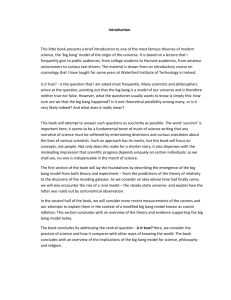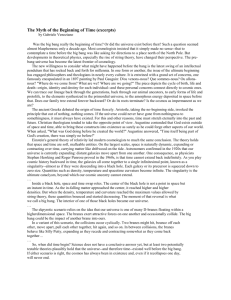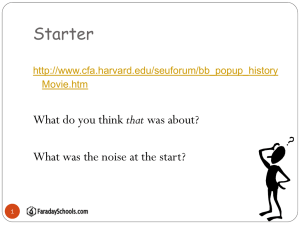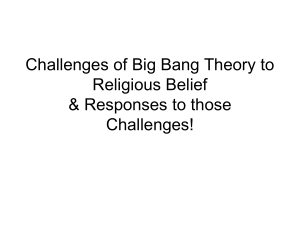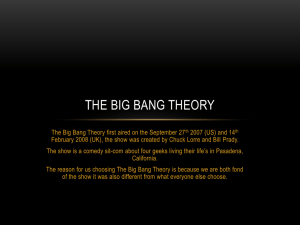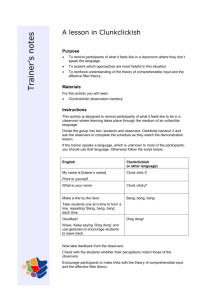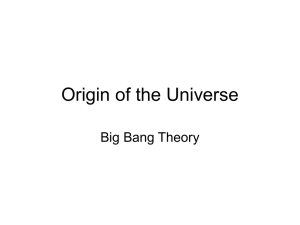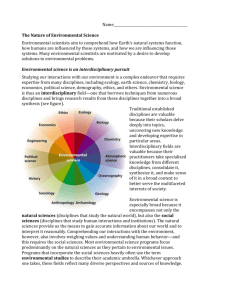221unittwosourceschartS08
advertisement
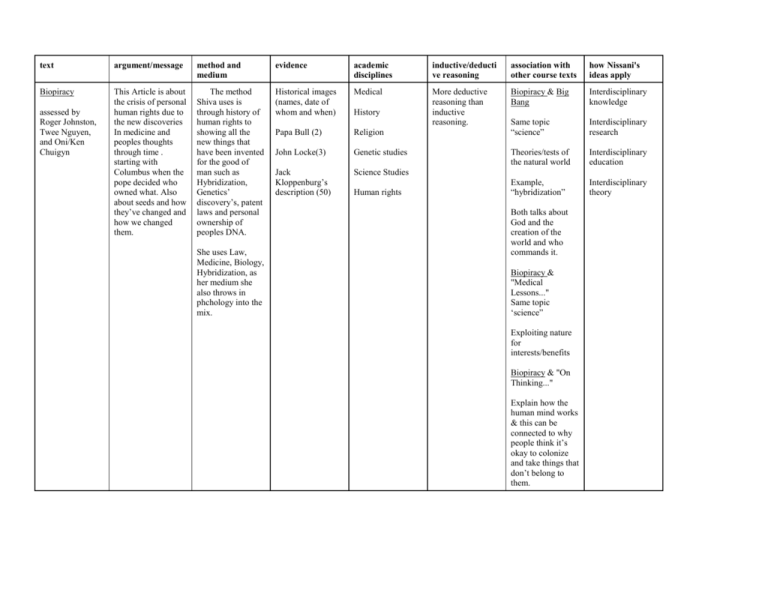
text argument/message method and medium evidence academic disciplines inductive/deducti ve reasoning association with other course texts how Nissani's ideas apply Biopiracy This Article is about the crisis of personal human rights due to the new discoveries In medicine and peoples thoughts through time . starting with Columbus when the pope decided who owned what. Also about seeds and how they’ve changed and how we changed them. The method Shiva uses is through history of human rights to showing all the new things that have been invented for the good of man such as Hybridization, Genetics’ discovery’s, patent laws and personal ownership of peoples DNA. Historical images (names, date of whom and when) Medical More deductive reasoning than inductive reasoning. Biopiracy & Big Bang Interdisciplinary knowledge Papa Bull (2) Religion Same topic “science” Interdisciplinary research John Locke(3) Genetic studies Theories/tests of the natural world Interdisciplinary education Jack Kloppenburg’s description (50) Science Studies Example, “hybridization” Interdisciplinary theory assessed by Roger Johnston, Twee Nguyen, and Oni/Ken Chuigyn She uses Law, Medicine, Biology, Hybridization, as her medium she also throws in phchology into the mix. History Human rights Both talks about God and the creation of the world and who commands it. Biopiracy & "Medical Lessons..." Same topic ‘science” Exploiting nature for interests/benefits Biopiracy & "On Thinking..." Explain how the human mind works & this can be connected to why people think it’s okay to colonize and take things that don’t belong to them. "Medical Lessons From History" We have antibiotics and vaccines. assessed by Fowsiya Nur, Jonathan Hoffman, and Joseph Lotin We cannot afford today's version of science and technology. We may someday learn fow the brain works. Compare and constrast of biology revolution. Research on tuberle bacillus to cure tuberculosis Occurance in medicine. desease could be turned by treatment with medicine. Looking back frome the distance. How far biology has come from the past. Learn to prevent rhematic fever. technology history biology/medicial research pharmocology economics physics antibiotics/pinicilin e/streptomyecine He decuces that there is still long way to go for meducal science despite all the acheivements. education We still don't know how the brain works. Shiva "Physics in medicine" Mann, Espilation of the past history in medicine/bio Brief History by Hawking Fruit salad metaphor/smoothie ; many were integrated. The disciplines were well integrated. Big Bang assessed by Lenny Kyle Paul Ciulla AyeAye San The message here is to explain how a supposedly simple yet incredible big bang theory (and other scientific achievements) came into existence through centuries of big and little discoveries by gifted scientific and imaginative thinkers who built upon a foundation knowledge. Simon Singh insinuates that myths came first and were necessary in order to stimulate the intellect of the scientific community to bravely challenge not only the scientific thought of their generation but mythological and religious powers of their time. It is organized, in parts, chronologically but he does jump around a little. He compares scientific evidence and experiments to contrasting myths. Black and white diagrams help to simplify the scientific methods that were used at that time. I think it is introduced well by the precursors “Coherent descriptions for the creation and evolution of the universe….fabulou s imagination, acute observation and ruthless logic” (1) and the quote by Karl Popper “Science must begin with myths, and with the criticism of myths” (qtd. in Singh 1) Galileo Galilei statement “I do not feel obliged to believe that the same God who has endowed us with sense, reason and intellect has intended us to forgo their use”(qtd. in Singh 1) supports the Argument. Singh states “All in all, the roots of the big bang model and the desire for a scientific theory of the universe can be traced right back to the decline of the ancient [and not so ancient] mythological view of the world” (4). Singh acknowledges bravery of early philosophers, “The word ‘myth’ is derived from the Greek word mythos, which can mean ‘story’, but also means ‘word’ in the sense of ‘the final word’. Indeed, anybody who dared to question these explanations would have laid themselves open to accusations of heresy” (Singh 6). Building on the foundation of knowledge is recognized by Singh with “ It was now possible for Eratosthenes to deduce the size of the Moon and the Sun, and their distances from the Earth. Much of the Groundwork had already been laid by earlier natural philosophers” (13). Egyptians were successful technologists without having science knowledge and on the other hand, Eratosthenes was scientists and they were not technologists. Therefore, Science and technology has different kinds of goal but there was no clue chemical and biochemical mechanisms works. (Singh, 19) Math, Technology, Physics, Astronomy, Geography, Science, Mythology, Religion. Philosophy, Environmental Science Deductive thinking from the development of science and technologies by encountering mythology influences Big bang model and the desire of scientific theory were foundation from the way of ancient people seeing the world where were came from the ancient legends and mythological perspective. 600BC Chinese creation mythcreator emerges and the creation process also created one man who came from egg to the world. This myth encourage to believe the people‘s perception who blindly faith in supernatural being and explaining the whole universe. The mythological faith in every culture was adopted in its society so some culture need to encounter The philosopher, cosmologist were study the universe but the words cosmology came from ancient Greek ( Singh 1-6) “Medical lessons from History “is like Big Bang (the mythology history was traced back and the process of technologies and science development) “Visual thinking” by Arnheim (seeing perception is not mental process of thinking.) “Holmberg’s Mistake” by Mann (Science way to approach to the history) Page 4 Paragraph 1, Big Bang: the Big Bang model of the universe was developed over the last hundred years, and this was only possible because twentiethcentury breakthroughs were built upon a foundation of astronomy constructed in previous centuries “1491: New Revelations of the Americas Before Columbus” by Mann New technology was used in examining old theories and information Page 4 Paragraph 1, Big Bang: The Big Bang model of the universe was developed over the last hundred years, and this was only possible because twentiethcentury breakthroughs were built upon a foundation of astronomy constructed in previous centuries “Medical Lessons from History” by Thomas Uses history to propagate the new Big Bang theory Two or more subject discipline combine like interdisciplinary study for example – Geosciences, environmental earth science, which studies field need to combined subjects like Physics, Math, and Biology that is, apply in the interdisciplinary continuum. Nissani would call this a smoothie because the combined disciplines lead to a new theory, the Big Bang theory Page 2, Paragraph 6, Fruit Salads and Smoothies: “ That is, by combining Apollonus’s work on conic sections with Tycho Brahe’s data on Mars, Kepler was able to come up with the first law of planetary motion (Koestler, 1959) Page 3, Paragraph 1, Fruit Salads and Smoothies: “…that incorporation or integration of disciplinary perspectives into a larger, more holistic perspective is the chief distinguishing characteristic of interdisciplinary studies.” "On Thinking About Thinking" assessed by Sam Abu-Nasser, Meredith Watlington ® Thinking could be result of the environment sensed by the person and sent to be interpreted by the mind. (M) Putting Thoughts together and how they are formed. - “Thinking” putting thoughts together. - The idea that one can work from the outside in to form thoughts and expressions. - He is using multiple disciplines to explain metacognition and cognition. - Chronological - Familiar subjects–>Music & Dance -points out facts on how thoughts work (pg 151), -chronological method, -uses things we are familiar with (dance, music pg 154) to explain his ideas. -he uses similes and analogies. - Not enough support/facts presented for an audience without previous knowledge in neurology and other brain science disciplines. There is no real evidence presented just statements and definitions. -Psychology, Neurology, Human Biology, Music - physics ( new orbits around the new dense mass and nothing can escape the attraction) - astronomy (black hole) - dance - music - ( I don’t know if this is a discipline…..boati ng(docking and locking) (note from Meesh: Yes, it is a discipline, but not an academic discipline.) - Deductive Reasoning - General –> Specific He dives right in and is talking on a micro level….(pg 151 “human head is filled alive with molecules of thoughts called notions.”) -“Dancing with the Professors” - Author not afraid to put out neck for a point he wants to make In an argument with many intense disciplines intermixed. - The Intelligence of Visual Perception because both readings talk about thinking and cognition. -Smoothie - Few but related disciplines(number ) - disciplines are blended well together. - built upon newly found scientific facts - highly integrated - A fruit salad consisting of guavas, kiwis, and blueberries. Brief History of Time classnotes recorded by ? Sam Abu-Nasser -Topic: space time -Time is not absolute ® Time specific to observer (M) We discovered time overtime beginning with Einstein -Space/Time is curved - Chronological - History? --> Compare&Contrast - Diagrams/Figures - Black/White - Previous Research - Names Researchers - Physical experiment (23) - Thought experiment (21) - E=mc^2 (24) - Physics, Mathematics, [Algebra/Geometry ], Astronomy, Philosophy, Cartography, Geography. - Singh? (same topic) -Mann? (history to explain new thinking) - Thomas? [b/c use audience to trace thinking process. - Could be viewed as smoothie or salad. - Depends on audience and their previous knowledge. - Pg. 4, 2nd Paragraph...Interdis ciplinary mixtures.
